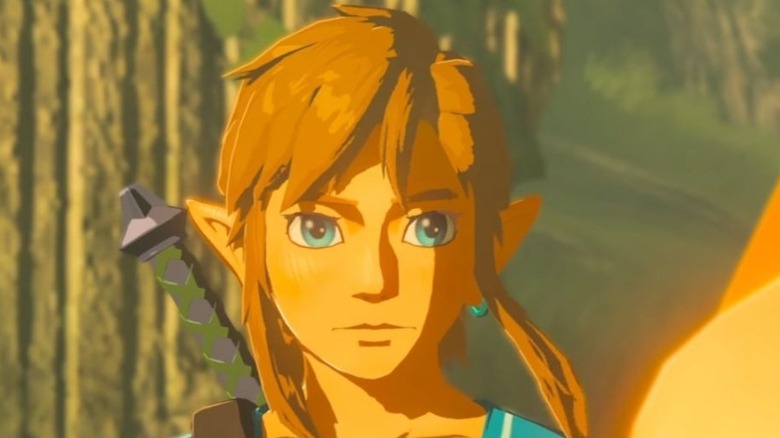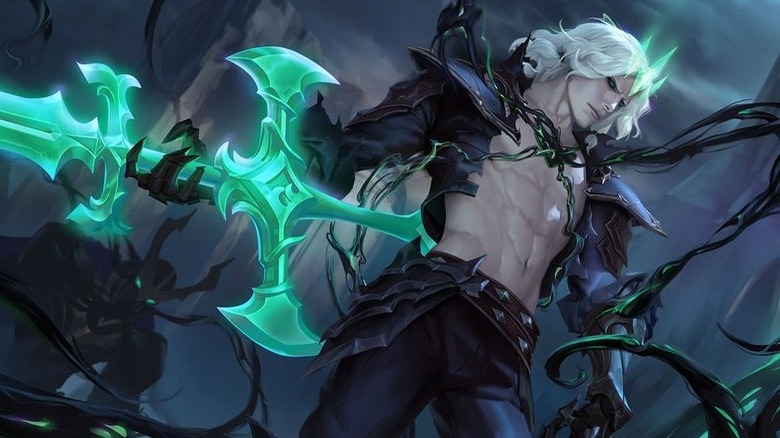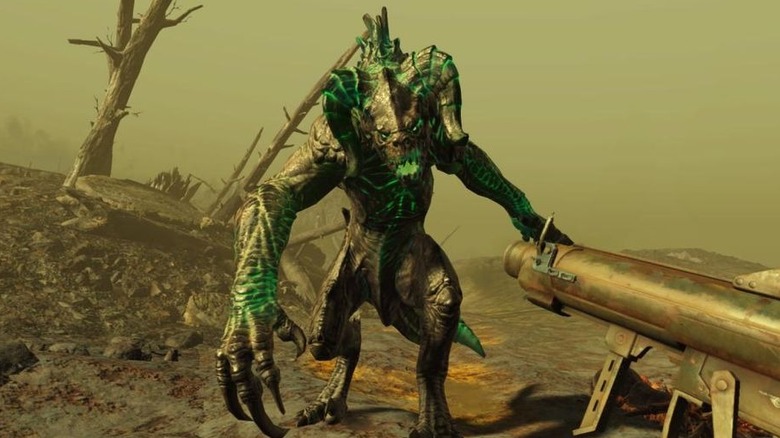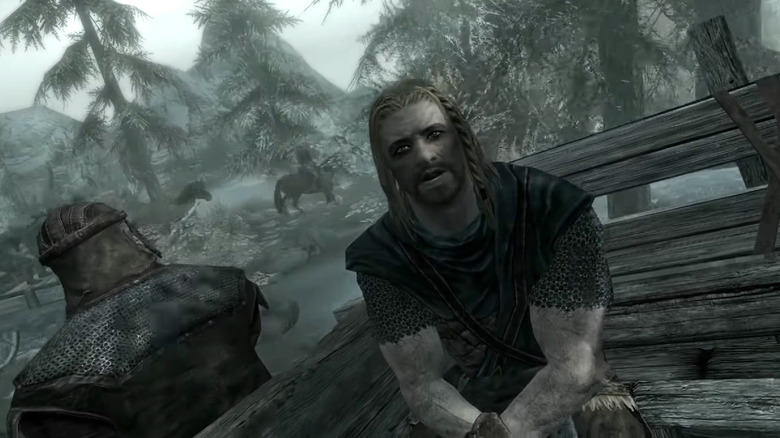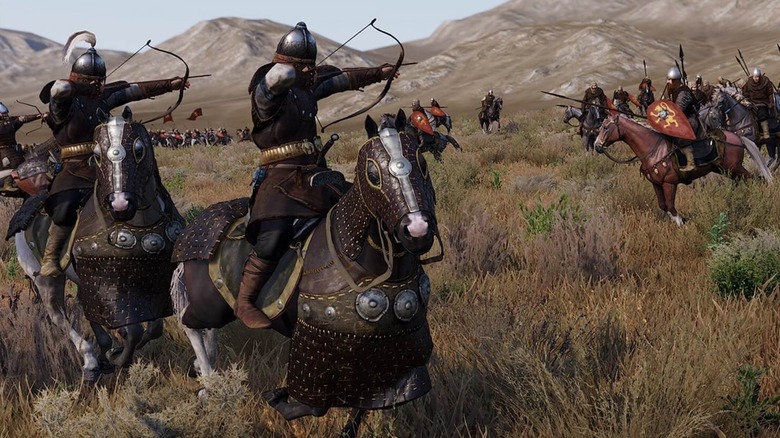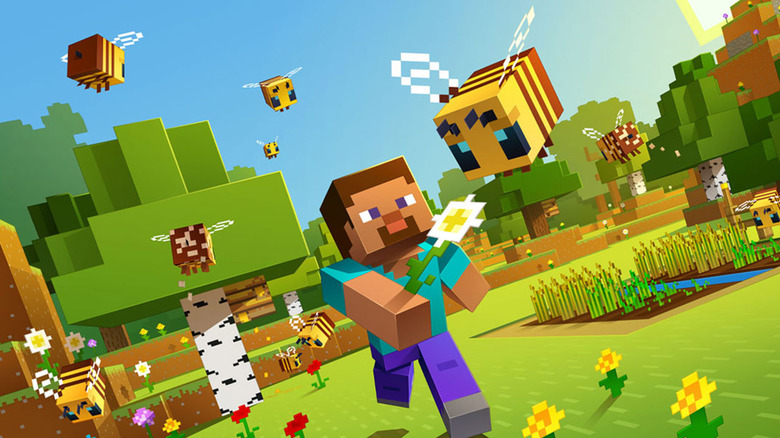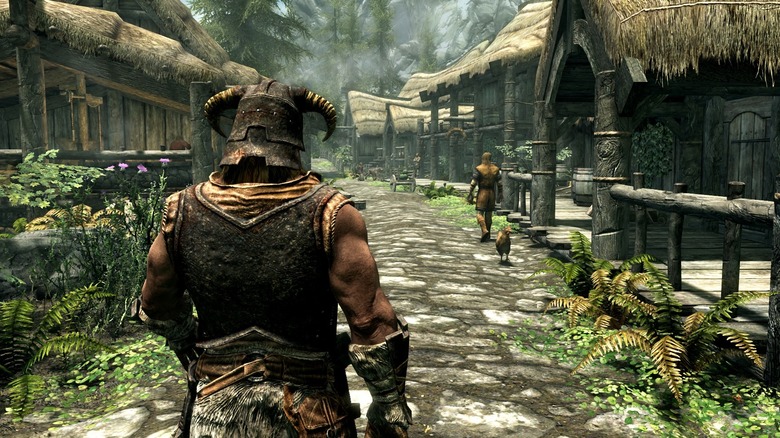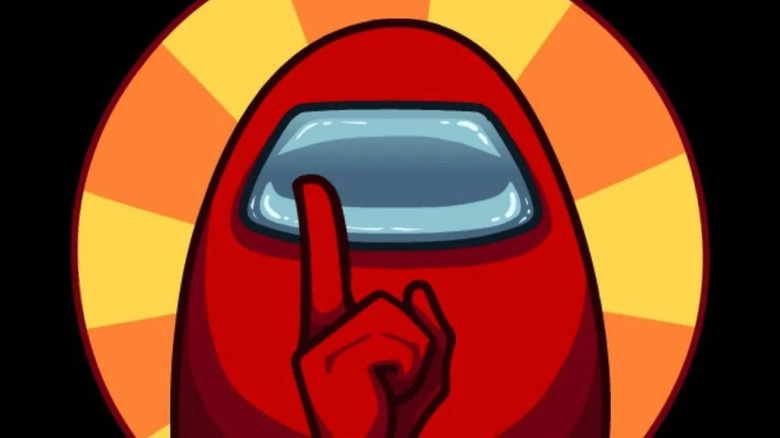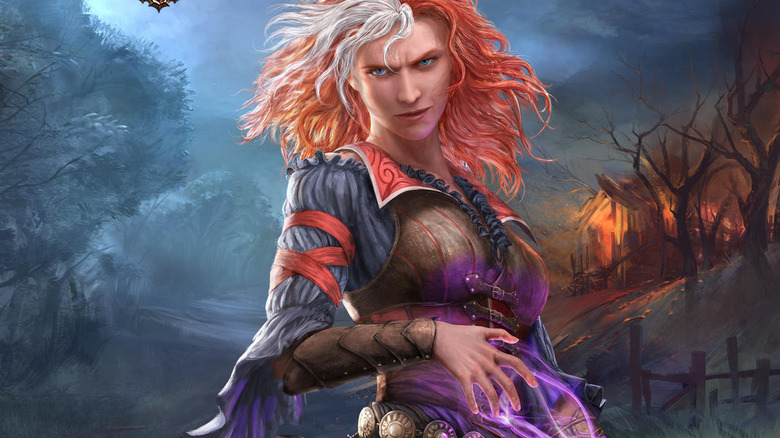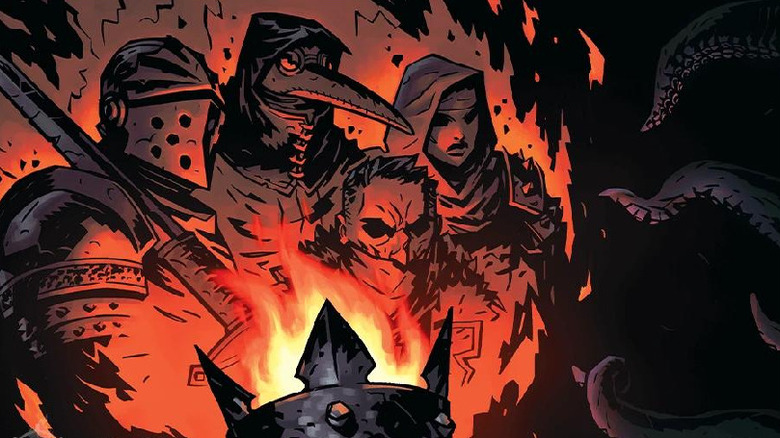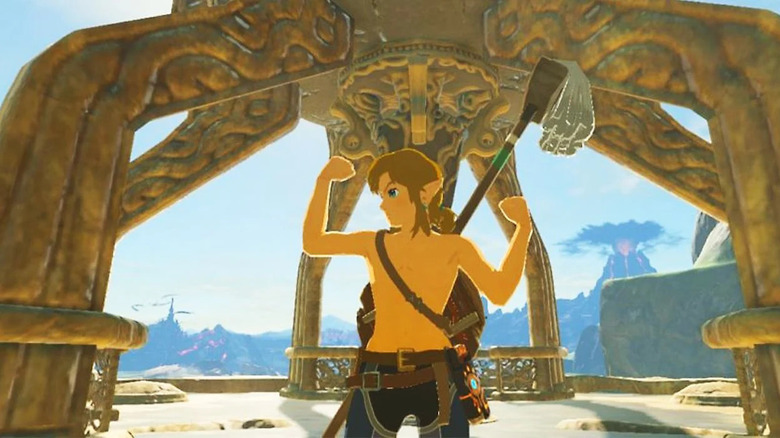Fan Modes That Completely Change The Game
Most games give players the impression of branching pathways or a sprawling system that they are free to explore. In truth, however, these pathways almost always converge back to one main road. After all, most stories have to eventually come to a close. That's why some player communities take it upon themselves to create their own rules — and with that, a new type of gameplay emerges.
A fan mode in a game, therefore, is separate from a mod in that it does not tamper with the original code of the game. Instead, fan modes only introduce new ways to play inside the game as it was originally released, typically through a series of self-imposed rules. Titles like "Little Big Planet" and "Super Mario Maker" have fully embraced custom fan-made modes as the heart of their gameplay loop.
As social media communities continue to merge with gaming spaces, fan modes are only becoming more popular. Here are just a handful of the truly inventive fan modes that completely change the game they sprang from.
Speedrunning
Have you ever tried to do something faster than you've ever done it before? Given yourself a few benchmarks to reach and tested your prowess again and again? Maybe it's a morning routine like finding the quickest commute to work, or maybe it's how fast you can complete "Super Mario Bros." in one sitting.
Speedrunning is the practice of setting personal and community records for meeting a specific goal in a game as fast as possible. It could be a full completion of the game, it could be beating the first boss, it could even be speedrunning towards revealing Mario's nipple in Super Mario Odyssey (via Speedrun). Regardless of the feat, speedrunning is an art of insanity — trying over and over to shave off a tenth of a second towards setting a new record.
Traced all the way back to the Nintendo World Championship of 1990, where competitors combined their high scores of "Rad Racer," "Tetris," and "Super Mario Bros.," speedrunning has always had a place amongst esports at large gaming conventions. Speedrunning communities have cultivated a stellar reputation within the gaming world by organizing events like GDQ (Games Done Quickly). These events produce millions of dollars for charity drives every year. The combined growth of marathon charity drives and streamer culture means speedrunning has cemented itself as a beacon of community-driven playstyles.
Pokémon - Nuzlocke and Ludlocke
The "Pokémon" game formula has been mastered over 30 years, creating one of the strongest brands across all entertainment. Despite being produced as children's games, the "Pokémon" brand has many lifelong hardcore fans who come up with ways to toughen up the challenge far beyond the trials of the Elite Four or Catching 'Em All.
A Nuzlocke run, inspired by a particularly dark web-comic (per Vox), has become synonymous with "player-enforced hard mode" across various game communities. The rules of a Nuzlocke confine the player to catching only the first Pokémon seen on each route and naming it to grow an attachment. If that new buddy ever faints, then it's considered dead forever and is released. If the player loses all Pokémon, then the Nuzlocke run is failed.
While the "Pokémon" games are designed with accessibility in mind, the Nuzlocke embraces strategy gamers. What was once a pleasant stroll through the Kanto region becomes a grueling trek. Bushes no longer present joyous opportunities of catchable Pokémon. Instead, they act as landmine-filled warzones in which the player hopes to avoid the dreaded words, "A wild Rattata has appeared." Nurse Joy can no longer bring your Pokémon friends back to health.
For those not too impressed with the challenge of a Nuzlocke, popular Twitch streamer Ludwig Ahgren has introduced a furthering of the concept with the Ludlocke challenge. The new rules include naming the caught Pokémon after Twitch chatters, who then get banned for the rest of the duration of the Ludlocke if their namesake ends up dying. Also, Ludwig has banned the use of potions in combat.
League of Legends - ARAM
A titan of the gaming industry for more than a decade, "League of Legends" is one of the most played games across the world with over 115 million active monthly users in 2021. Its core game map, Summoner's Rift, has stood the test of time thanks to its industry-standard three-lane map setup. Sometimes though, playing vanilla just isn't fun enough.
As explained by Vandiril on YouTube, in the early days of matchmaking, ARAMs started either as custom games or player-led initiatives, because there was no official ARAM mode. The rules of early ARAM matches directed players to not leave the midlane at any point. Players were also not allowed to recall to the team fountain, farm adjacent jungle camps, or do anything outside the mid-line besides die.
In 2012, Riot Games stoked the flames while they were hot and modified the introductory map into an ARAM-specific map with the release of the Howling Abyss. No longer could players recall to the fountain or venture out beyond the walls of the now-singular lane. Over time, Riot Games introduced ARAM-specific game balancing to help against the dominance of long-range champions.
To this day, ARAM remains the second most popular format for playing "League of Legends." ARAM matches have been produced with celebrity groupings at large "League of Legends" tournaments as a fan-favorite treat. In other words, this fan mode quite literally changed the game forever.
Fallout 4 - Pacifist Runs
Few action RPG franchises are more beloved than the "Fallout" series, and the hype surrounding the 2015 release of "Fallout 4" rivaled any other AAA release — as did its violence. Bethesda director Todd Howard did not beat around the bush when telling The Guardian in 2015, "I can't tell you that you can play the whole game without violence – that's not necessarily a goal of ours – but we want to support different play styles as much as we can."
As it turns out, playing without violence is actually a goal of plenty of players. "Fallout: New Vegas" offered players layers of subterfuge, misdirection, and social manipulation to explore. "Fallout 4," on the other hand, seems to expect the bodies to pile up, regardless of the player's choices.
Taken as a challenge by a small group of players, the pacifist "Fallout 4" community worked together to figure out a way to end the game without a single person, robot, animal, or Radroach being slain. As described by Kotaku, the process itself is sheer madness: everything wraps around a single perk, "Wasteland Whisperer," which allows players a chance to pacify NPCs. If an NPC isn't pacified when they need to be, then players need to reload their save until it works.
YouTuber Kyle Hinckley posted his entire successful pacifist run in 2015, illustrating how he and his community nearly broke the game multiple times in completing the game without conflict. There are a few unavoidable deaths that bottleneck the progression of the story, which led to Hinckley having to figure out how to get those specific NPCs to take themselves out.
Skyrim - Vegan Runs
Out of all the endless ways "Skyrim" can be played, playing as a vegan has got to be one of the hardest variations. At first glance, maybe it seems like it wouldn't much of a hindrance — just fry up some greens instead of a steak around the campfire, you know? It couldn't be that challenging to avoid slaying any animals or using any animal products, could it?
Well, it could, and it is. As soon as the protagonist's head escapes their execution at the start of the game, PCGamesN's Cian Maher points out that you have to immediately take all your leathers off. And make sure you don't use that sinew-strewn bow or those metal armors and weapons made by those meat-loving blacksmiths. Also, the Stormcloaks are always wearing and decorating with furs, so you have to pick the right faction for your new lifestyle. Keep it herbal and shepherd any attacking animals into greener pastures instead of killing them.
Except for dragons, because dragons are not quite "real" animals — and because the protagonist technically has to consume their souls in order to beat the game. As Maher observed, "souls aren't corporeal and are therefore not really an animal product, right?".
As long as players can bend a few rules around the nature of absorbing dragon souls, then beating "Skyrim" as a vegan is entirely possible.
Mount and Blade 2: Bannerlord - Archers Only
Strategy war games focus heavily on troop type. Typically, the infantry goes in the front, the archers in the back, and the cavalry on the flanks. While the historical accuracy of this strategy may vary, what doesn't vary is adaptability. But what if adaptability is thrown out the window? Like, so far out the window that the player doesn't consider any other path to victory besides the arcing volleys of arrows across the battlefield?
When a battle begins in "Mount and Blade 2: Bannerlord," opposing armies start far across the simulated terrain, giving players time to set up a general formation before the engagement. Instead of setting up a normal formation in an "archer only" play, all the player has to do is sit on a hilltop and wait for the enemy to charge, loosing every arrow possible until the attack is just upon the first ranks. At the critical moment of breakthrough, the player pauses the game and presses retreat.
The battle ends technically as a "loss," but the casualty charts tell a different story. Every soldier that died or faced critical injury will be registered at the end of the battle. Once the crowd has thinned out a bit and the player has retreated, they can just re-engage the same army and repeat this process until the opposing army looks like a porcupine from the sheer number of arrows.
This is one self-imposed fan mode that doubles as a handy exploit. In fact, TheSpiffingBrit, a YouTuber known for popularizing this exploit, followed a long tradition of pushing war games to their limits with archers.
Minecraft - Nomad Run
Following the trend of limiting the player's resources, "Minecraft" Nomad runs specify players can only keep what they carry and must never sleep in the same place twice. Call it extreme inventory management, call it hardcore survival, or even call it an exercise in not hoarding. Whatever it is, this fan mode's unique hook has more to it than meets the eye.
With the goals of "Minecraft" being ultimately up to the player, this play mode can take a couple of different shapes. For those not inclined towards the hardcore challenge of killing the Ender Dragon, a nomadic playthrough can be primarily an exploration adventure. Naturally, players will build their own settlements, but a nomad has no taste for such stagnant scenery. There's nothing to tie the player down in a Nomad run.
In Nomadic runs, you have to keep moving and build your own resources, meaning you only have what you can carry. Each new shiny piece of gear means only more when it costs a whole inventory slot to keep it. When hoarding is cut out, everything becomes more valuable.
In order to take on end-game content like the Ender Dragon, players must find ways to level-up their characters while avoiding spending the night in the same place twice. No designated crafting areas or automated resource farms here; only a bed, backpack, and 63 other inventory slots. Players must use these slots wisely, because "Hard Mode" is required to complete this challenge, meaning you can't exploit deaths as a means of shuffling inventory.
Skyrim - Blind and Weary
"Skyrim" is a cornucopia full of juicy ideas. Aside from vegan playthroughs, fans have devised ways to up the difficulty with things like the "Blind and Weary" challenge. Turn your difficulty all the way up and turn off all player UI — including your health bar, mana bar, and mini map — and start playing "Skyrim" like you actually live there.
The minimization of information given by the HUD strips players of the tools they're used to and turns up the intensity. When the bumper lanes take down their guards then the real bowlers show up. It's easy enough to get lost in the sprawling landscape of "Skyrim," delving into dungeons and moving from cave to cave in order to stay alive. But with your map and quest markers out of the picture, finding your way to and from even the simplest side-quest becomes a challenge in itself. The world feels quite a bit bigger now, doesn't it?
Among Us - Hide and Seek
Summer 2020 offered much-needed new ways of interacting with friends online. That is, you got to call them all liars and turn them on each other, all while taking them out one by one in the dark. "Among Us" changed the face of mainstream social gaming, and along with its popularity came a community dedicated to constantly evolving the game.
A community favorite is the "Hide and Seek" mode, which rules that a single Imposter announces themself at the start of the match and gives everybody 10 seconds to hide. Crewmembers must complete 5 short tasks while remaining out of sight, and they can never call a meeting. Finally, the Imposter's vision is reduced to 0.5x while the crewmates' vision is raised to 4.0x.
Instead of social deduction and manipulation ruling the experience, the game's chore mechanics and map knowledge reign supreme. While the Imposter has to basically breathe on someone to see them, crewmembers can see them coming from a mile away.
Without the ability to call meetings, crewmates have almost no recourse if they get trapped in a room. The Imposter must do their best to block communications so players don't know their tasks. This can leading to a round of wild chases, misdirection, and caged-animal anxiousness. Knowing who is coming to get you makes it all the scarier, especially when they catch your trail and you have nothing to do besides run.
Divinity: Original Sin 2 - Telekinesis Only Challenge
Many game developers would never consider allowing every single piece of furniture and food to be movable by the players, due to the sheer amount of unforeseen consequences that would arise. Developer Larian Games threw caution to wind when allowing players to interact with everything through a scaling telekinetic strength system. The result is "Divinity: Original Sin 2," an immersive and critically acclaimed RPG — as well as some super cheesy strategies. As explained by The Spiffing Brit, the Telekinesis Only Challenge One turns players into an unstoppable looting and killing machine.
Since telekinesis is a scaling attribute — allowing players to move any grab-able item a certain distance, regardless of weight — all that is required for this awesome trick is a super heavy object that will not break down in durability. Almost like it was coded for this loophole, the standard Gold Chest can fit tens of thousands of pounds of cargo while being the only item in the game with no durability issues. So get a Gold Chest and fill it up with the heaviest stuff you can find.
The heavier the chest, the more damage it deals to foes when dropped or flung into them. Since players can fit bags inside of chests, they also gain access to hundreds of extra inventory slots.
While many fan modes make the game harder to accomplish, this is more of an exploit that can lead to some really funny gameplay. After all, why wouldn't the player want to experience the power of a Jedi, bending material reality with their will?
Darkest Dungeon - No Light Challenge
Roguelikes have taken the strategy genre by a storm in the past few years, with "Darkest Dungeon" as one of its most respected members. Admired by critics and gamers for its gritty aesthetic and novel combat lineup, the community around "Darkest Dungeon" has held strong together since its release. Not only is there a vibrant mod community for "Darkest Dungeon," but fan modes have been created and sustained by influencers and their community, including the No Light Challenge.
Light, non-coincidentally, is a core mechanic in "Darkest Dungeon", a game about venturing into pitch-black dungeons. An adventuring party consists of four characters with their own health points and sanity level, which act as knock-out mechanics if they reach their thresholds. In order to keep sanity levels high, light must be kept as bright as possible through the use of torches and special abilities. In this challenge, however, players must venture forward in complete darkness.
Not only are there a ton of negative modifiers attached to playing in pitch darkness — more stress generation, higher monster accuracy and damage, higher surprise rate on heroes, less loot, etc. — there is also an added chance that players are ambushed in every single room, even if mobs weren't supposed to spawn there.
This mode is simply about putting the game on super-extra hard mode and making it as far as possible. Heroes that have higher resolve and sanity restoring abilities are an absolute must, but accomplishing this feat will probably take multiple failed attempts. Aside from the mechanical demands of the challenge, the feeling of leading a crew of nocturnal psychopaths around in the dark sounds awesome.
Terraria - Merfolk Challenge
Much like their kinfolk over in "Minecraft," the dedicated community of "Terraria" players have invented countless modes of playing the same game in different ways. When a game develops around player expression and communities grab ahold of something and make it their own, great things can happen — but so can weird things, like the Merfolk Challenge.
"Terraria" allows players to equip a fish bowl with water in it as their helmet, naturally drowning the player. "Terraria" also allows players to equip a trinket called Neptune's Shell that enables players to transform into Merfolk mode while underwater, granting players unlimited breath and normal walking speed. In effect, equipping both these items will make you suffocate on land and breath normal in water, turning you into a de facto member of the Merfolk for the entire run of the game.
The challenge is encouraged to be done with multiple people, but only with everyone doing it together, much like a school of Merfolk would. Merfolk runs have been attempted and shared multiple times, as the challenge of living as a fish on a map dedicated to tunneling the earth continues to appeal to a certain set of players.
The Legend of Zelda: Breath of the Wild - No Pause Challenge
Frankly, no other game has scratched the surface of what "The Legend of Zelda: Breath of the Wild" achieved in its open world sandbox. Built on the premise of not setting the player on railroad tracks, "Breath of the Wild" has become a bastion of player community challenges.
One of the most challenging player-defined modes — if not the most challenging — is the No Pause Challenge. As explained by Gamechamp 3000, no pause menus are ever allowed to be accessed during this run. At face value, it doesn't seem like too difficult, but it actually hampers the player in almost every conceivable way. If menus are also counted among pauses (since they interrupt the flow of gameplay), then the player can never eat anything, never equip anything from their inventory, never fast travel, and never manually save.
In order to complete the challenge, the player must defeat Calamity Ganon on Master Mode and reach the story's True Ending. The amount of forethought and perfect execution required to complete this challenge is stunning. From perfectly timing gear and weapon equips to getting max health just to avoid dying on Death Mountain, the list of complicated strategies goes on and on.
Out of all the player modes, the No Pause Challenge has to be the most demanding outside of world record speedruns. It also encapsulates the beauty of player-enforced modes. They force a reconsideration of systems often taken for granted, they turn decision-making into a methodical process requiring massive amounts of game knowledge, and they organically grow games into community favorites.

